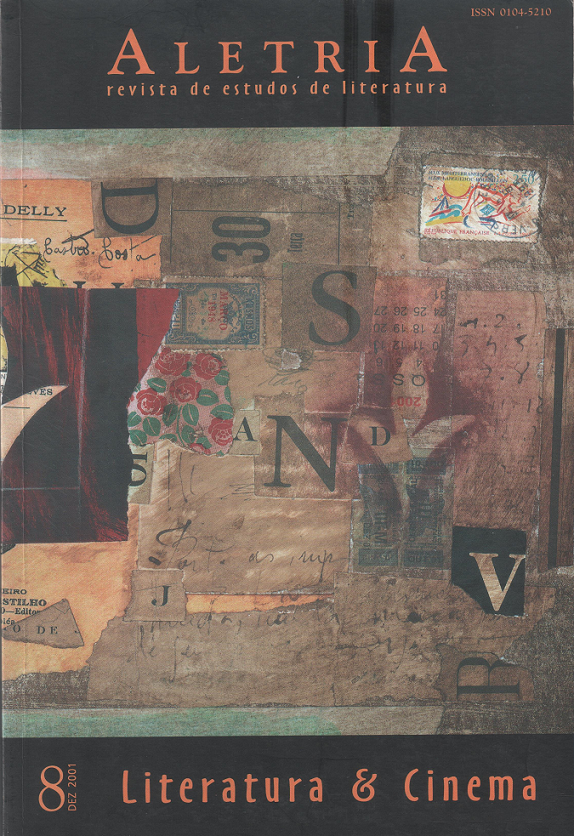O conceito de Kinostil e o princípio da montagem no romance Berlim Alexanderplatz, de Alfred Döblin
DOI:
https://doi.org/10.17851/2317-2096.8..194-210Palabras clave:
German literature, montage and film, montage and literature, literature and film, novel of the big city.Resumen
Resumo: O objetivo do presente artigo é apresentar alguns aspectos teóricos postulados pelo escritor alemão Alfred Döblin ao desenvolver sua própria concepção da obra épica na “era da técnica”. Tais aspectos contribuem para uma melhor compreensão da relação entre literatura e cinema nas primeiras décadas do século XX.
Palavras-chave: literatura alemã; montagem e cinema; montagem e literatura; literatura e cinema; romance da grande cidade.
Abstract: The aim of this article is to present some theoretical aspects developed by the German writer Alfred Döblin in his own conception of the epic work in the “era of the technique”. These aspects contribute to a better comprehension of the relationship between Literature and Film in the first decades of the 20th century.
Keywords: German literature; montage and film; montage and literature; literature and film; novel of the big city.
Descargas
Citas
BENJAMIN, Walter. A obra de arte na era de sua reprodutibilidade técnica (1935/1936). In: ______. Magia e técnica, arte e política; ensaios sobre literatura e história da cultura. 3.ed. Trad. Sérgio Paulo Rouanet. São Paulo: Brasiliense, 1987. p.165-96.
BERNADET, Jean-Claude. O que é cinema. São Paulo: Brasiliense, 2000. (Primeiros Passos, 9).
DÖBLIN, Alfred. An Romanautoren und ihre Kritiker. Berliner Programm (1913). In: ______. Schriften zu Ästhetik, Poetik und Literatur. Olten/Freiburg i. Br.: Walter-Verlag, 1989. p.119-23.
DÖBLIN, Alfred. Berlim Alexanderplatz; a História de Franz Biberkopf. Trad. Lya Luft. Rio de Janeiro: Rocco, 1995.
DÖBLIN, Alfred. Der Bau des epischen Werks. Die Neue Rundschau, ano 40, n.4. Berlim, abr. 1929. p.527-51.
DÖBLIN, Alfred. Futuristische Worttechnik. Offener Brief an F. T. Marinetti (1913). In: ______. Schriften zu Ästhetik, Poetik und Literatur. Olten/Freiburg i. Br.: Walter-Verlag, 1989. p.113-9.
EISENSTEIN, Sergei Mikhailovich. Dickens, Griffith e nós (1943). In: ______. A Forma do Filme. Trad. Teresa Ottoni. Rio de Janeiro: Jorge Zahar, 1990. p.173-216.
EISENSTEIN, Sergei Mikhailovich. Fora de quadro (1929). In: ______. A Forma do Filme. Trad. Teresa Ottoni. Rio de Janeiro: Jorge Zahar, 1990. p.35-47.
EISENSTEIN, Sergei Mikhailovich. Palavra e imagem (1941). In: ______. O sentido do filme. Trad. Teresa Ottoni. Rio de Janeiro: Jorge Zahar, 1990. p.13-47.
GUIMARÃES, César. Imagens da memória; entre o legível e o visível. Belo Horizonte: Editora UFMG, 1997.
GUNNING, Tom. Weaving a narrative; style and economic background in Griffith’s biograph films. In: ELSAESSER, Thomas, BARKER, Adam (Org.). Early cinema: space – frame – narrative. London: BFI Publishing, 1992. p.336-47.
HOLZ, Arno. Die Kunst. Ihr Wesen und ihre Gesetze. In: MEYER, Theo (Org.). Theorie des Naturalismus. Stuttgart: Reclam, 1973. p.168-74.
MARINETTI, Filippo Tommaso. “Manifesto Técnico” da Literatura Futurista (11 de maio de 1912). In: BERNARDINI, Aurora Fornoni (Org.). O futurismo italiano – Manifestos. São Paulo: Perspectiva, 1980. p.81-7. (Debates: arte).
NAZÁRIO, Luiz. Contra o cinema conceitual. In: ______. As sombras móveis; atualidade do cinema mudo. Belo Horizonte: Editora UFMG, 1999. p.90-124.
PUDOVKIN, Vsevolod Illarionovich: Filmtechnique (1929). In: ______. Film technique and film acting. London: Vision Press, 1954.
ZMEGAC, Viktor. Montage/collage. In: BORCHMEYER, Dieter; ZMEGAC, Viktor (Org.). Moderne Literatur in Grundbegriffen. Frankfurt a.M.: Athenäum, 1987. p.259-64.
Descargas
Publicado
Cómo citar
Número
Sección
Licencia
Derechos de autor 2001 Elcio Loureiro Cornelsen (Autor)

Esta obra está bajo una licencia internacional Creative Commons Atribución 4.0.
Authors who publish with this journal agree to the following terms:Authors retain copyright and grant the journal right of first publication with the work simultaneously licensed under a Creative Commons Attribution Non-Commercial No Derivatives License that allows others to share the work with an acknowledgement of the work's authorship and initial publication in this journal.Authors are able to enter into separate, additional contractual arrangements for the non-exclusive distribution of the journal's published version of the work (e.g., post it to an institutional repository or publish it in a book), with an acknowledgement of its initial publication in this journal.Authors are permitted and encouraged to post their work online (e.g., in institutional repositories or on their website) prior to and during the submission process, as it can lead to productive exchanges, as well as earlier and greater citation of published work (See The Effect of Open Access).





